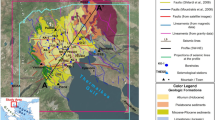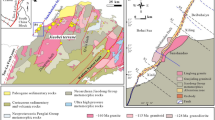Abstract
Geocellular modeling has become extremely important, linking all petroleum disciplines, and being widely used in simulation and production forecasting in complex basin studies. In this study, we focused on the Minwal–Joyamair Fields in the Upper Indus Basin (UIB), Pakistan, which contains Cambrian to Eocene reservoir formations. Changes in sedimentary environments and structural activities within the UIB have resulted in reservoir heterogeneity, which has adversely affected reservoir performance, and it is still not fully understood. Geocellular modeling was used in this study to better understand the structural framework of the Cambrian to Eocene formations in the UIB. The 2D seismic and well log data from the Minwal–Joyamair Fields are the primary data for building the geocellular model for the Eocene (Chorgali, Sakesar) and Paleocene (Lockhart) reservoirs. The developed structural model is then populated with petrophysical properties such as porosity. The upscaled porosity for the Eocene carbonate rock units ranges 1–3%. On the other hand, the Cambrian and Permian (Tobra & Khewra) clastic reservoirs bear porosity of 3–10%. The upscaled porosity can be utilized to predict the lateral and vertical distribution in these reservoirs. Furthermore, the evaluated upscaled correlation for Eocene reservoirs (80–90%), whereas for Permian (Tobra) and Cambrian (Khewra) reservoirs, it lies between 60 and 70 %. Apart from data availability, a complete geocellular model of the field was produced, encompassing the petrophysical and facies model. The geocellular models created a high-resolution 3D reservoir model of this complex geology that can be applied to similar geology worldwide to identify prospective zones.






















Similar content being viewed by others
Notes
mmboe = millions of barrels of oil equivalent; 1 barrel of oil equivalent = 6.1178632 × 109 Joules
References
Abdelnabi, A., Liu, K., & Gao, S. (2016). A full field static model of the RG-oil field, central Sirte Basin, Libya. In Proceedings of the SEG technical program expanded abstracts (pp. 2057–2061). https://doi.org/10.1190/segam2016-13846377.1
Abdullah, E. A., Abdelmaksoud, A., & Hassan, M. A. (2022). Application of 3D static modelling in reservoir characterization: A case study from the qishn formation in sharyoof oil field, Masila Basin, Yemen. Acta Geologica Sinica-English Edition, 96(1), 348–368.
Adeoti, L., Onyekachi, N., Olatinsu, O., Fatoba, J., & Bello, M. (2014). Static reservoir modeling using well log and 3-D seismic data in a KN field, offshore Niger Delta, Nigeria. International Journal of Geosciences, 5(1), 93–106.
Ali, A. M., Radwan, A. E., Abd El-Gawad, E. A., & Abdel-Latief, A.-S.A. (2022). 3D integrated structural, facies and petrophysical static modeling approach for complex sandstone reservoirs: A case study from the Coniacian–Santonian matulla formation, July Oilfield, Gulf of Suez, Egypt. Natural Resources Research, 31(1), 385–413.
Ali, F., Khan, M. A., Usman, M., & Cheema, L. S. (2021). Economic assessment of prospective shale gas play in Pakistan using discounted cashflow model. Arabian Journal of Geosciences, 14(23), 1–11.
Amjad, M. R., Ehsan, M., Hussain, M., Al-Ansari, N., Rehman, A., Naseer, Z., Ejaz, M. N., Baouche, R., & Elbeltagi, A. (2023). Carbonate reservoir quality variations in basins with a variable sediment influx: A case study from the Balkassar Oil Field, Potwar, Pakistan. ACS Omega, 8, 4127–4145.
Ashraf, U., Anees, A., Shi, W., Wang, R., Ali, M., Jiang, R., Vo Thanh, H., Iqbal, I., Zhang, X., & Zhang, H. (2022). Estimation of porosity and facies distribution through seismic inversion in an unconventional tight sandstone reservoir of Hangjinqi area, Ordos basin. Frontiers in Earth Science, 10, 1–17.
Ashraf, U., Zhang, H., Anees, A., Ali, M., Zhang, X., Shakeel Abbasi, S., & Nasir Mangi, H. (2020). Controls on reservoir heterogeneity of a shallow-marine reservoir in Sawan Gas Field, SE Pakistan: Implications for reservoir quality prediction using acoustic impedance inversion. Water, 12(11), 1–23.
Ashraf, U., Zhang, H., Anees, A., Mangi, H. N., Ali, M., Zhang, X., Imraz, M., Abbasi, S. S., Abbas, A., & Ullah, Z. (2021). A core logging, machine learning and geostatistical modeling interactive approach for subsurface imaging of lenticular geobodies in a clastic depositional system, SE Pakistan. Natural Resources Research, 30(3), 2807–2830.
Asquith, G. B., & Gibson, C. R. (1982). Basic well log analysis for geologists. In American association of petroleum geologists, Thlsa, Oklahoma USA. https://doi.org/10.1306/Mth3425
Colombera, L., Yan, N., McCormick-Cox, T., & Mountney, N. P. (2018). Seismic-driven geocellular modeling of fluvial meander-belt reservoirs using a rule-based method. Marine and Petroleum Geology, 93, 553−569. https://doi.org/10.1016/j.marpetgeo.2018.03.042
Daud, F., Khan, G. N., & Ibrahim, M. (2011). Remaining hydrocarbon potential in Pakistan–a statistical review. In Proceedings of the PAPG/SPE annual technical conference (ATC) Islamabad, Pakistan (pp. 1–14).
DiPietro, J. A., & Pogue, K. R. (2004). Tectonostratigraphic subdivisions of the Himalaya: A view from the west. Tectonics, 23, 1–20.
Ehsan, M., Gu, H., Ali, A., Akhtar, M. M., Abbasi, S. S., Miraj, M. A. F., & Shah, M. (2021). An integrated approach to evaluate the unconventional hydrocarbon generation potential of the Lower Goru Formation (Cretaceous) in Southern Lower Indus basin. Pakistan. Journal of Earth System Science, 130(2), 90.
Francis, A. (2018). A simple guide to depth conversion: Part II. GEO ExPro Magazine, 15(3), 1–6.
GhojehBeyglou, M. (2021). Geostatistical modeling of porosity and evaluating the local and global distribution. Journal of Petroleum Exploration and Production Technology, 11, 4227–4241.
Gilbert, R., Liu, Y., Abriel, W., & Preece, R. (2004). Reservoir modeling: Integrating various data at appropriate scales. The Leading Edge, 23(8), 784−788. https://doi.org/10.1190/1.1786903
Gomes, J., Parra, H., & Ghosh, D. (2018). Quality control of 3D GeoCellular models: examples from UAE carbonate reservoirs. In Proceedings of the Abu Dhabi international petroleum exhibition and conference, Abu Dhabi, UAE (pp. 1–37). https://doi.org/10.2118/193128-MS
Grana, D., Paparozzi, E., Mancini, S., & Tarchiani, C. (2013). Seismic driven probabilistic classification of reservoir facies for static reservoir modelling: a case history in the Barents Sea. Geophysical Prospecting, 61(3), 613–629.
Hook, J. R. (2003). An introduction to porosity. Petrophysics, 44(03). https://onepetro.org/petrophysics/article-abstract/171017/An-Introduction-to-Porosity?redirectedFrom=fulltext
Islam, M. A., Yunsi, M., Qadri, S. M. T., Shalaby, M. R., & Haque, A. K. M. E. (2021). Three-dimensional structural and petrophysical modeling for reservoir characterization of the mangahewa formation, Pohokura Gas-Condensate Field, Taranaki Basin. New Zealand. Natural Resources Research, 30(1), 371–394.
Kadri, I. B. (1995). Petroleum geology of Pakistan. Pakistan Petroleum Limited, Karachi, Pakistan.
Khan, H. K., Ehsan, M., Ali, A., Amer, M. A., Aziz, H., Khan, A., Bashir, Y., Abu-Alam, T., & Abioui, M. (2022). Source rock geochemical assessment and estimation of TOC using well logs and geochemical data of Talhar Shale, Southern Indus Basin, Pakistan. Frontiers in Earth Science, 10, 1–15.
Khan, M., Nawaz, S., & Radwan, A. E. (2023). New insights into tectonic evolution and deformation mechanism of continental foreland fold-thrust belt. Journal of Asian Earth Sciences, 245, 1–20.
Kimple, D., Peterson, E. W., & Malone, D. H. (2015). Stratigraphy and porosity modeling of South-Central Illinois (USA) chester (upper mississippian) series sandstones using petrel. World Journal of Environmental Engineering, 3(3), 82–86.
Oliver, M. A., & Webster, R. (2015). Basic steps in geostatistics: the variogram and kriging. Springer.
Orellana, N., Cavero, J., Yemez, I., Singh, V., & Sotomayor, J. (2014). Influence of variograms in 3D reservoir-modeling outcomes: An example. The Leading Edge, 33(8), 890–902.
Paasche, H., Tronicke, J., Holliger, K., Green, A. G., & Maurer, H. (2006). Integration of diverse physical-property models: Subsurface zonation and petrophysical parameter estimation based on fuzzy c-means cluster analyses. Geophysics, 71(3), H33–H44.
Qadri, S. M. T., Islam, M. A., Shalaby, M. R., & Eahsan ul Haque, A. K. M. (2017). Seismic interpretation and structural modelling of Kupe field, Taranaki Basin, New Zealand. Arabian Journal of Geosciences, 10(14), 1–17.
Qayyum, A., Poessé, J. W., Kaymakci, N., Langereis, C. G., Gülyüz, E., & Ahsan, N. (2022). Neogene kinematics of the Potwar plateau and the Salt range, NW Himalayan front: A paleostress inversion and AMS study. International Geology Review, 64(9), 1311–1329.
Radwan, A. E. (2022). Chapter Two—Three-dimensional gas property geological modeling and simulation. In D. A. Wood & J. Cai (Eds.), Sustainable geoscience for natural gas subsurface systems, Vol. 2 (pp. 29–49). Gulf Professional Publishing. https://doi.org/10.1016/B978-0-323-85465-8.00011-X
Rahimi, M., & Riahi, M. A. (2020). Static reservoir modeling using geostatistics method: A case study of the Sarvak Formation in an offshore oilfield. Carbonates and Evaporites, 35, 1–13.
Rider, M. H. (2011). The geological interpretation of well logs (3rd ed.). Rider-French.
Searle, M. P., Khan, M. A., Fraser, J. E., Gough, S. J., & Jan, M. Q. (1999). The tectonic evolution of the Kohistan-Karakoram collision belt along the Karakoram Highway transect, north Pakistan. Tectonics, 18, 929–949.
Shami, B. A., & Baig, M. S. (2002). Geomodelling for the enhancement of hydrocarbon potential of Joya Mair Oil Field, Potwar, Pakistan. In Proceedings of the SPE/PAPG annual technical conference, Islamabad, Pakistan (pp. 1–22).
Sisinni, V., McDougall, N., Victoria, M., Vallez, G. Y., & Estaba, V. V. (2016). Facies modeling described by probabilistic patterns using Multi-point statistics an application to the k-field, Libya. In Proceedings of the AAPG/SEG international conference and exhibition, Barcelona, Spain (pp. 229–229). https://doi.org/10.1190/ice2016-6320106.1
Thom, J., & Hocker, C. (2009). 3-D grid types in geomodeling and simulation–How the choice of the model container determines modeling results. In Proceedings of the AAPG annual convention and exhibition, Denver, Colorado, USA (pp. 1–32).
Wandrey, C. J., Law, B. E., & Shah, H. A. (2004). Patala–Nammal composite total petroleum system, Kohat–Potwar geologic province, Pakistan (pp. 1–20). Reston: US Department of the Interior, US Geological Survey. http://pubs.usgs.gov/bul/b2208-b/
Weltje, G. J., Dalman, R., Karamitopoulos, P., & Quinto, S. (2013). Reducing the uncertainty of static reservoir models: implementation of basin-scale geological constraints. In Proceedings of the EAGE annual conference and exhibition incorporating SPE Europec, London, UK (pp. 1–7). https://doi.org/10.2118/164821-MS
Wrobel-Daveau, J.-C., Barracloughy, R., Laird, S., Matthies, N., Saeed, B., Shoaib, K., & Zafar, Z. (2021). Insights on fractured domains in reservoirs resulting from modeling complex geology/structures - case study of the ratana field in the Potwar Basin, Pakistan. In Proceedings of the SPE middle east oil and gas show and conference (pp. 1–12). https://doi.org/10.2118/204737-MS
Acknowledgments
The authors would like to express their utmost gratitude to the Directorate General of Petroleum Concession (DGPC) of Pakistan for providing the essential data required for this research. Furthermore, our special thanks and appreciation to LMK Resources Pakistan (Private) Limited (LMKR), Islamabad, Pakistan, Petrel, and the Geophysical Lab of the Department of Earth and Environmental Sciences, Bahria University Islamabad, Pakistan, for providing the necessary platform and software to successfully conduct this research within the stipulated timeframe. Deep thanks and gratitude to the Researchers Supporting Project number (RSP2023R351), King Saud University, Riyadh, Saudi Arabia, for funding this research article.
Author information
Authors and Affiliations
Corresponding author
Ethics declarations
Conflict of Interest
The authors declare that they have no known competing financial interests or personal relationships that could have appeared to influence the work reported in this paper.
Rights and permissions
Springer Nature or its licensor (e.g. a society or other partner) holds exclusive rights to this article under a publishing agreement with the author(s) or other rightsholder(s); author self-archiving of the accepted manuscript version of this article is solely governed by the terms of such publishing agreement and applicable law.
About this article
Cite this article
Ehsan, M., Latif, M.A.U., Ali, A. et al. Geocellular Modeling of the Cambrian to Eocene Multi-Reservoirs, Upper Indus Basin, Pakistan. Nat Resour Res 32, 2583–2607 (2023). https://doi.org/10.1007/s11053-023-10256-7
Received:
Accepted:
Published:
Issue Date:
DOI: https://doi.org/10.1007/s11053-023-10256-7




